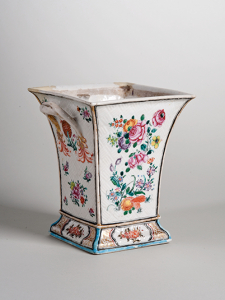Chinese blue and white porcelain was among many Asian sources of inspiration for European and American artists and designers in the nineteenth and early twentieth centuries. Today, these precious Asian ceramic pieces are still avidly collected and enjoy a large popular audience. In the eighteenth century, two regional variations of porcelain—Canton and Nanking (both produced in the port city of Guangzhou)—emerged. The industry served westerners eager to add an exotic element to their dining rooms. Complete sets of Canton porcelain, fashioned to accommodate European eating traditions, were embellished with broad brushstrokes of toned blues depicting flowers, village scenes, and interweaving patterning. Nanking wares reflected the higher quality of export porcelain. They featured evenly executed cobalt scenes in more refined detail, often embellished with gold accents. Artists like James Abbott McNeill Whistler (1834–1903) and Louis Comfort Tiffany (1848–1933) admired the ornamentation of these Chinese ceramics and incorporated them into some of their most famous interiors. This vignette exhibits numerous examples of these in-demand Chinese ceramics ranging from around 1740 to 1890. The works were collected over the course of forty years by life-long Orlando residents Dr. Benjamin L. and Nancy Abberger and recently donated to the Morse Museum by the Abberger family.



